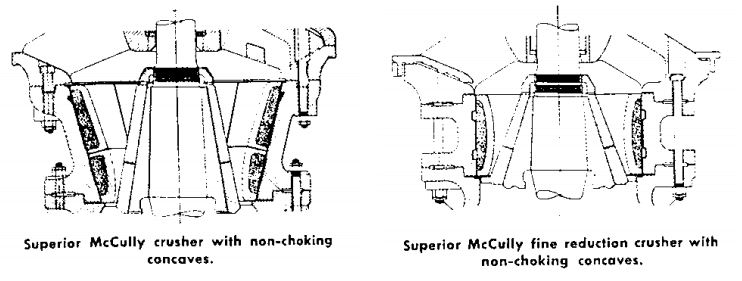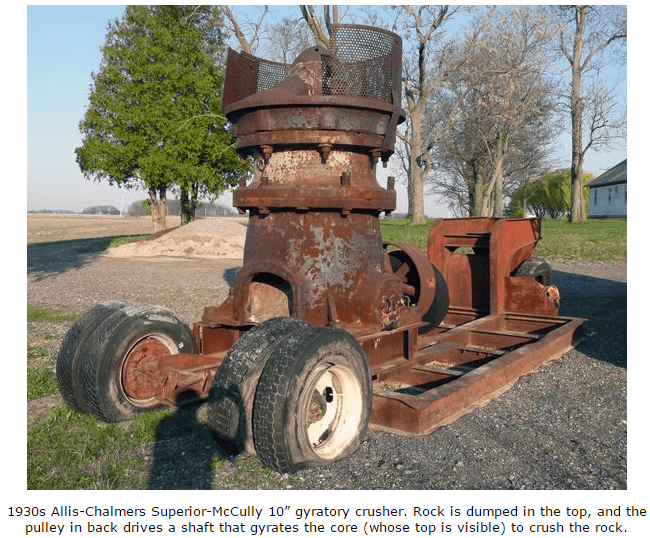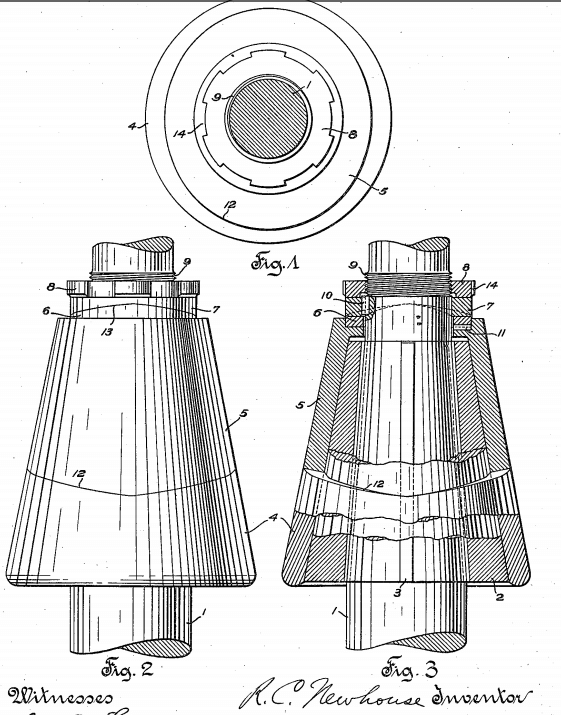 The use of large primary crushers made secondary crushing necessary, but this department was taken care of nicely by the existing lines of standard gyratory machines. In commercial crushed stone plants, there was gradual increase in the number of products, but generally a sufficient demand existed for the coarser grades for ballast and macadam roads to absorb the output. So for a time everything went along quite comfortably in this respect, and the operator concerned himself with the problem of getting out increased tonnage, selling his product as it was made, or stocking it during off-seasons for any particular grades.
The use of large primary crushers made secondary crushing necessary, but this department was taken care of nicely by the existing lines of standard gyratory machines. In commercial crushed stone plants, there was gradual increase in the number of products, but generally a sufficient demand existed for the coarser grades for ballast and macadam roads to absorb the output. So for a time everything went along quite comfortably in this respect, and the operator concerned himself with the problem of getting out increased tonnage, selling his product as it was made, or stocking it during off-seasons for any particular grades.
Then came reinforced concrete, and with it a rapidly increasing demand for small sizes of crushed stone and gravel. It is hard to say when this demand began to assume sizeable proportions, but soon commercial plants began to feel the effects of it, and to look for a remedy. For some time, as was quite logical, the remedy consisted of installing more small secondary crushers, generally small gyratories. This procedure assumed rather startling proportions in some large plants. For example, the array of crushers in the plant comprised one 48″ primary, four No. 7.5 secondaries and a battery of finishing crushers that included four No. 6 and twelve No. 4. All were gyratories, although later, two sets of crushing rolls were added to augment the production of small stone.
Probably the earliest attempt to adapt the standard gyratory for reduction crushing service was the short-head arrangement, which consisted simply of an abbreviated crushing head, installed in the standard machine, with concaves to match. This device did not prove to be very successful; crushing stresses were concentrated at a point where the top shell was ill fitted to withstand them, and the throw at the point of discharge was too small to take full advantage of the increased diameter of discharge opening. Chronologically, this adoption is a rather venerable one; it antedates by a number of years the more serious efforts to develop special fine-reduction crushers, a development which did not gather headway until 1915 or so.
It would be a difficult matter to as certain just where this development had its inception; probably a great deal of parallel work was being done at the time by the various crusher builders. One of our own early experiments along these lines was the installation of special concaves in several of the No. 4 crushers in the plant to reduce the crushing angle. The results were encouraging enough to start a more thorough investigation into the design of crushing chambers.
The disc crusher was one of the first special machines brought out for fine crushing, and for several years this new type enjoyed a wide popularity. The single toggle jaw crusher was developed in larger sizes, and because it could be operated at closer settings than similar sizes of the Blake type, found quite a field of service in small plants as a reduction crusher.
The first important development in the move to adapt the gyratory crusher to fine crushing was the debut of the Superior McCully fine-reduction crusher, which was brought out a few years before Allis-Chalmers took over these crushers. This machine was designed along lines identical to those of the standard Superior McCully crusher with one important exception: instead of the orthodox tapered top shell of the standard machine, the new crusher was fitted with a cylindrically bored shell, the concaves being vertical and reversible. The crushing head was flared correspondingly, this additional flare resulting, for a given size of receiving opening, in a head of much larger diameter. For example, whereas the standard crusher with 10″ receiving opening has a head diameter of about 27″ at the bottom, the corresponding dimension for the 10″ reduction crusher is about 40″ Eccentric speeds were increased, and throws were adjusted for operation at close settings. Originally these machines were fitted with straight-face concaves; later the concaves were tapered at both ends to distribute the wear better; eventually non-choking concaves became standard equipment.
It would be difficult for us, and tedious for the reader, were we to attempt to chronicle all of the development work, some of it successful and some not, which went on in the decade following the end of the first World War. One important contribution to the art was the high-speed, direct-connected Newhouse crusher, which introduced a new principle of crushing for cleanness and uniformity of product.
Some 20 years ago the principle of the widely flared crushing head was combined with some other new and radical departures from current practice, and the cone crusher entered the reduction crushing field. Two interesting innovations incorporated in this machine were an unusually large throw and a spring loaded and adjustable crushing bowl.
Special Gyratory Concaves: About the same time that the cone crusher appeared, at least three different builders applied the principle of curved-profile crushing chambers, certainly the most important and far reaching improvement in crusher design that had been made for many years and possibly the greatest since the inception of the gyratory type. In our own case this development took the form of “non-choking” concaves, which could be installed in any of the existing models of gyratory crusher without any change in the shape of the crushing head. The type quickly became standard equipment in our reduction crushers, the Newhouse and Superior McCully fine reduction machines. But of equal importance was the fact that the efficiency of many hundreds of existing standard machines, of all ages and styles, was markedly improved at a very nominal cost by substituting these new curved concaves for the old straight-face liners.
All crushers developed up to this time, except the very large machines of the gyratory type, were provided with some means of adjustment to compensate for wear or to adjust for variations in product size. The range of adjustment in most machines was small; adjustments in most cases required shutting down the machine. In the gyratory types, after a certain amount of adjustment was made, it was necessary to reset the concaves. This did not constitute any serious drawback in primary and secondary crushing service, because wear was slow generally and the exact setting of discharge opening was not a critical matter. With the increase in demand for fine crushing the situation altered; it was necessary to set crushers closer and to maintain the setting within closer limits. It was immediately apparent that a crusher with a large range of adjustment, without the necessity of resetting the wearing parts, would be very desirable; as a matter of fact, the first cone crushers brought out incorporated such a feature, which proved to be very popular.
Crushing engineers have studied this problem along the lines of combining wide range with speed of adjustment. The result of this study was the introduction of the idea of supporting the main-shaft on an oil-operated hydraulic jack. This idea was first incorporated in a special model of the Newhouse crusher, designated as the “Oil-Adjusted” crusher, A few of these machines were built and tested under severe operating conditions, and the line would undoubtedly have been developed extensively had not the “quiet” period through the early 1930’s effectively checked the demand for new crushers.
We had not lost sight of the possibilities of this method of adjustment, however, and when’Conditions showed signs of improvement we were ready to incorporate the oil adjustment feature into an entirely new machine, a machine which was to be designed in all its proportions specifically for reduction crushing, with a scientifically proportioned crushing chamber, “quick-set” adjustment, safety release for tramp-iron protection, and high speed operation for maximum capacity at close settings. This machine, the “Type R,” was brought out early in 1938.
Big and giant primary gyratories come with memories of the first World War. As a matter of fact, there is not a great deal more to tell so far as these machines are concerned, except for one more big jump in top size. This machine, which had reached a 48″ receiving opening by 1910 and 54″ shortly thereafter, was developed a few years later into the 60″ size.
The first 60″ machines was built in 1926-27, and these crushers two of which were installed in a South American copper mine, set a world record in weight and proportions which still stands. These giant machines, weighing about 500 tons each, and rearing their steel frames to the height of a two-story building, are indeed a long step forward from the first tiny No. 2 Gates crusher that came out of the little shop in Chicago some 60 years ago.
https://www.911metallurgist.com/rock-crusher-history
https://www.hcea.net/page-1680142/44585132
